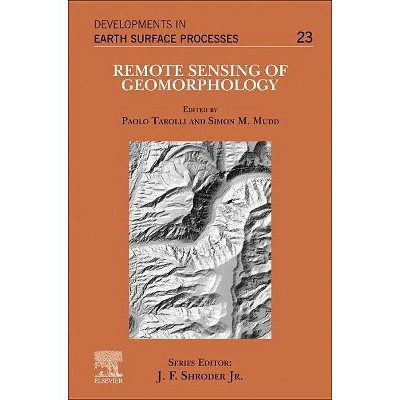Remote Sensing of Geomorphology, 23 - (Developments in Earth Surface Processes) (Paperback)

Similar Products
Products of same category from the store
AllProduct info
<p/><br></br><p><b> Book Synopsis </b></p></br></br><p><i>Remote Sensing of Geomorphology, Volume 23, </i> discusses the new range of remote-sensing techniques (lidar, structure from motion photogrammetry, advanced satellite platforms) that has led to a dramatic increase in terrain information, and as such provided new opportunities for a better understanding of surface morphology and related Earth surface processes. As several papers have been published (including paper reviews and special issues) on this topic, this book summarizes the major advances in remote sensing techniques for the analysis of Earth surface morphology and processes, also highlighting future challenges. Useful for MSc and PhD students, this book is also ideal for any scientists that want to have a single volume guideline to help them develop new ideas. In addition, technicians and private and public sectors working on remote sensing will find the information useful to their initiatives.<p/><br></br><p><b> Review Quotes </b></p></br></br><br>Overall, this collection of articles is a commendable addition to the Developments in Earth Surface Processes book series. Main highlights of the book which may secure a place for it in the libraries of the university, research institutes as well as commercial Brms include: (i) an apt balance of basics and fundamentals of the ace technologies with elaborate case studies providing in-depth functional details, suggestions and guidelines for their trouble-free implementation; (ii) the book emphatically showcases the application, usability and significance of high-resolution topography in various geomorphological domains; (iii) it suitably covers all the major and significant areas of geomorphology in-vogue through the complied chapters; (iv) the careful inclusion of chapters with thorough reviews and those with dedicated applications, is noteworthy; (v) lastly, the lucid yet eAective style of writing followed throughout, together with justiBed, good quality and exclusive illustrations further enhance the understanding of concepts. In a nutshell, I deBne this compilation as a Bne mix of rich and updated reference source with adequate fundamental details which would beneBt a scholar and a seasoned researcher alike. <b>--J. Earth Syst. Sci.-Indian Academy of Sciences</b><br><p/><br></br><p><b> About the Author </b></p></br></br>Paolo Tarolli is Professor in Water Resources Management and Integrated Watershed Management, and PI of Earth Surface Processes and Society research group at the University of Padova (Italy). He has a PhD in Environmental Watershed Management and Geomatics and has worked as academic staff at the University of Padova since 2011. He is an expert in digital terrain analysis, earth surface processes analysis, natural hazards, geomorphology, hydro-geomorphology, LIDAR, and structure-from-motion photogrammetry. His new research directions include the analysis of topographic signatures of human activities from the local to regional scale. He is Deputy President of the Natural Hazards Division of the European Geosciences Union (EGU) and Deputy President of sub-division VII (Information and Communication Technologies) of the Italian Society of Agricultural Engineering. Prof. Tarolli is also Executive Editor of Natural Hazards and Earth System Sciences (Copernicus) and associate editor or editorial board member of several international journals. He is the author of more than 100 papers published in international peer-reviewed journals. He has given more than 20 invited talks in international research institutions and foreign Academies (i.e., Princeton University, EPFL, AgroParisTech, National Cheng Kung University, China University of Geosciences, Dalian University and Technology) and at international meetings (IGC, AAG, ISPRS, RGS-IBG, AOGS-AGU, Soil Science Society of China).
Price History
Price Archive shows prices from various stores, lets you see history and find the cheapest. There is no actual sale on the website. For all support, inquiry and suggestion messagescommunication@pricearchive.us




















